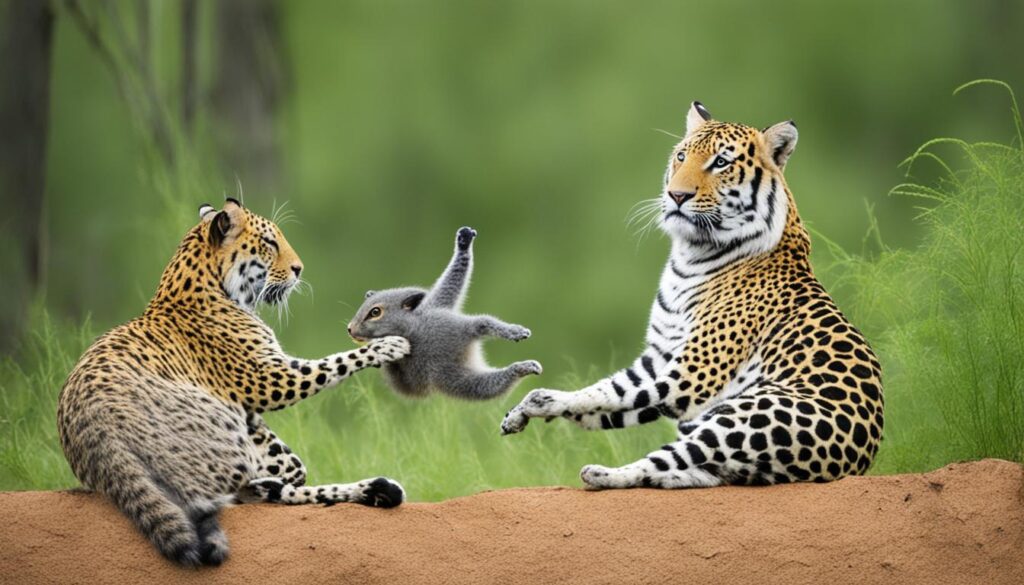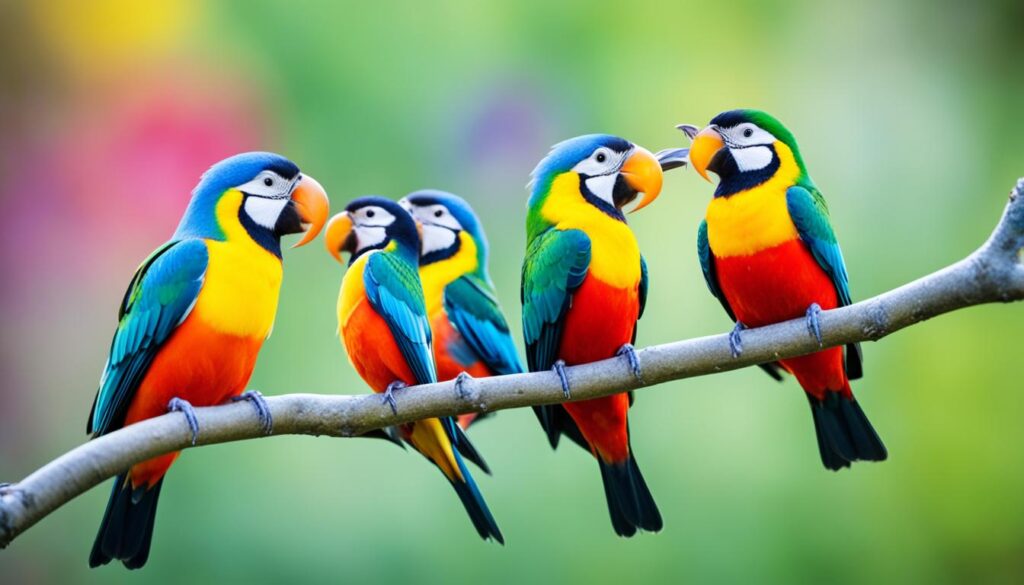The natural world is full of amazing ways animals talk to each other. They use many methods to share information, make friends, and survive. From mammals’ complex sounds to birds’ bright displays, animal communication is fascinating.
In this article, we’ll explore how animals talk to each other. We’ll learn about their language and why it’s important for understanding and saving wildlife.
Animals use many ways to communicate, like sounds and body language. These methods help them talk within their groups and even with other species. By studying animal communication, we learn more about nature and how it keeps ecosystems balanced.
Unveiling Nature’s Intriguing Language
The natural world is full of amazing ways that animals talk to each other. From the animal vocalization in dense forests to the nonverbal communication in the ocean, it shows us how animals have their own language.
Exploring the Fascinating Realm of Animal Communication
Animals use many ways to talk, both vocal and nonverbal. They use these to send messages, show feelings, and work together. For example, whales make deep calls, bees dance, and primates signal to each other in complex ways.
From Vocal Displays to Body Gestures
Animals make sounds like lions roar, birds chirp, and elephants rumble. These sounds make up a big symphony. They also use nonverbal communication, like a giraffe’s neck movements or a chimpanzee’s face.
Animals use these ways to share lots of information. They tell each other about food, danger, social rank, and who they are. Learning about wildlife behavior helps us understand the complex language of the animal world.
Animal Kingdom’s Diverse Communication Methods
The animal kingdom is full of fascinating ways that creatures talk to each other. They use everything from complex sounds to silent body language. Each method helps them share info, set social rules, and work together. Learning about these ways helps us understand nature better.
Animals often use more than one way to communicate, like seeing, hearing, and smelling. This helps them get their point across, even when it’s hard to hear or see. For example, some frogs show off bright colors and make low sounds to find a mate and scare off others.

Animals also talk to each other across different species. This helps predators and prey move safely and avoid fights. For instance, many birds and mammals can hear and react to warning calls from other animals. This helps them stay safe together.
Exploring how animals communicate shows us the complex world they live in. From loud primate calls to silent reptile moves, each way of signaling tells us about their thoughts and social lives. It’s amazing to see how they connect with each other.
Decoding the Secret Signals of Mammals
Mammals have advanced thinking and social skills. They use many ways to talk to each other. From wolves’ howls to primates’ facial expressions, they share info through vocalization, scent, and body language. This helps them show where they live, who they want to mate with, and their place in the group.
Interpreting Mammalian Calls and Behaviors
Understanding animal behavior of mammals tells us a lot about their social lives and how they survive. Rodents, dogs, and elephants make different sounds that mean different things. These sounds tell us about their feelings, who’s in charge, and how they react to their world.
Mammals also use body language to talk to each other. A dog’s raised hackles, a chimpanzee’s low posture, or a lion’s big display tells us a lot. By watching and understanding these signs, scientists can learn more about how mammals live.
Avian Symphony: The Language of Birds
Birds have a complex way of communicating with each other. They use many sounds, from beautiful songs to unique calls. These sounds help them share who they are, where they live, and if they’re looking for a mate. Learning about bird communication helps us understand their social lives and how they adapt to their environments.
The sounds birds make are not just random noises. Songbirds, for example, sing to mark their territory, find a mate, and talk to their babies. They can recognize each other’s songs, which is amazing. This skill lets them connect with others and respond in the right way.

Birds also use body language to talk to each other. They flap their wings, bob their heads, and arrange their feathers to show how they feel or what they want. This way, they can work together, set up social orders, and survive in their world.
By exploring how birds communicate, scientists learn more about their brains, how they adapt, and their social lives. This knowledge is not just interesting. It also helps us protect these amazing birds and their homes.
Aquatic Conversations: How Marine Life Communicates
Under the ocean, a magical world of communication happens. Whales and dolphins use sounds, while deep-sea creatures light up the darkness. This shows how different sea animals talk to each other. Learning about this helps us understand their lives better.
Unraveling the Mysteries of Underwater Communication
The ocean is full of ways for sea creatures to talk to each other. Whales and dolphins make sounds to share info, plan hunts, and find their way. They use clicks, whistles, and moans to chat with friends, find mates, and hunt for food.
But it’s not just about sounds. Some sea creatures use light to talk too. Like the glowing dinoflagellates and jellyfish that light up the sea. They use this to find friends, scare off enemies, and talk within their groups. These lights are like a secret language of the sea.
Scientists are still learning about how sea creatures communicate. By studying this, we get to know more about their amazing ways of living. It shows us how these creatures have adapted to life in the ocean.
Insect Communication: A Miniature Marvel
Insects have a complex way of communicating that’s as complex as human language. They use special methods to share important info, work together, and keep their colonies going. This world of insect communication is full of amazing adaptations from these tiny creatures.
Exploring the Intricate World of Pheromones
Pheromones are key to insect communication. These chemical signals help insects find mates, mark territory, and work together. Insects like ants and bees use pheromones to keep their groups organized and respond to their environment.
Ants can follow many different pheromone trails, each with its own message. Honeybees use pheromones too, like in their famous waggle dances. This way of talking helps them survive and work together.
Insects also use touch, sight, and sound to communicate. Crickets make sounds, fireflies flash lights, and some insects move together in big groups. These ways of sharing info help them live in many different places and adapt to changes.
Scientists and nature lovers are always learning more about how insects communicate. This shows us how complex and important these tiny creatures are in our world. By studying them, we learn more about the amazing life that surrounds us.
Animal Communication and Survival
In the wild, animals talk to each other in many ways. They use signals to warn others of danger or to find a mate. This talking is key to their survival and success in their homes.
Knowing how animals communicate helps us protect endangered species and keep ecosystems healthy. By understanding their language, we learn how they adapt and survive. This knowledge helps us make better conservation plans.
Animals use different ways to talk, like loud calls, colorful displays, or even smells. These methods show how clever they are at living in their worlds. By studying their language, we can help protect them better.
With more threats like habitat loss, saving animal communication is vital. It’s not just interesting to learn; it’s crucial for our planet’s health. By valuing animal language, we can help many species live together in balance with nature.
The Importance of Animal Language in Conservation
Understanding animal language is key to conservation. By studying how animals communicate, we learn about their social lives, what they need, and how they react to changes. This info helps us make better conservation plans and protect endangered species.
Keeping animal communication safe is crucial for wildlife conservation. Knowing how animals talk helps us understand their needs and adapt our conservation efforts. This way, we can help vulnerable populations survive. Researching and protecting animal language is vital for the health of our planet.
Protecting animal communication is a big part of protecting the environment. It helps not just the animals but also the whole ecosystem. By keeping these communication systems safe, we help keep our planet healthy for the future. By focusing on animal language, we can better protect the natural world and the life it supports.







